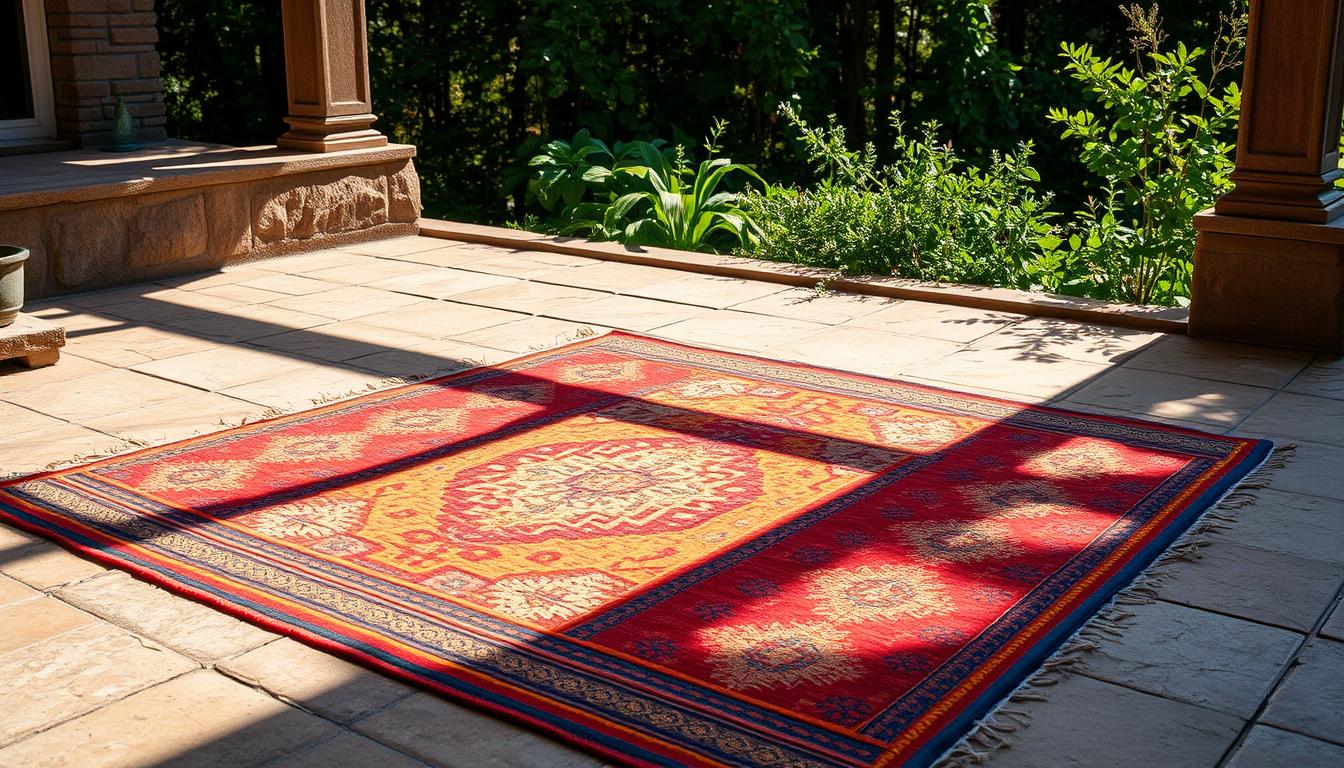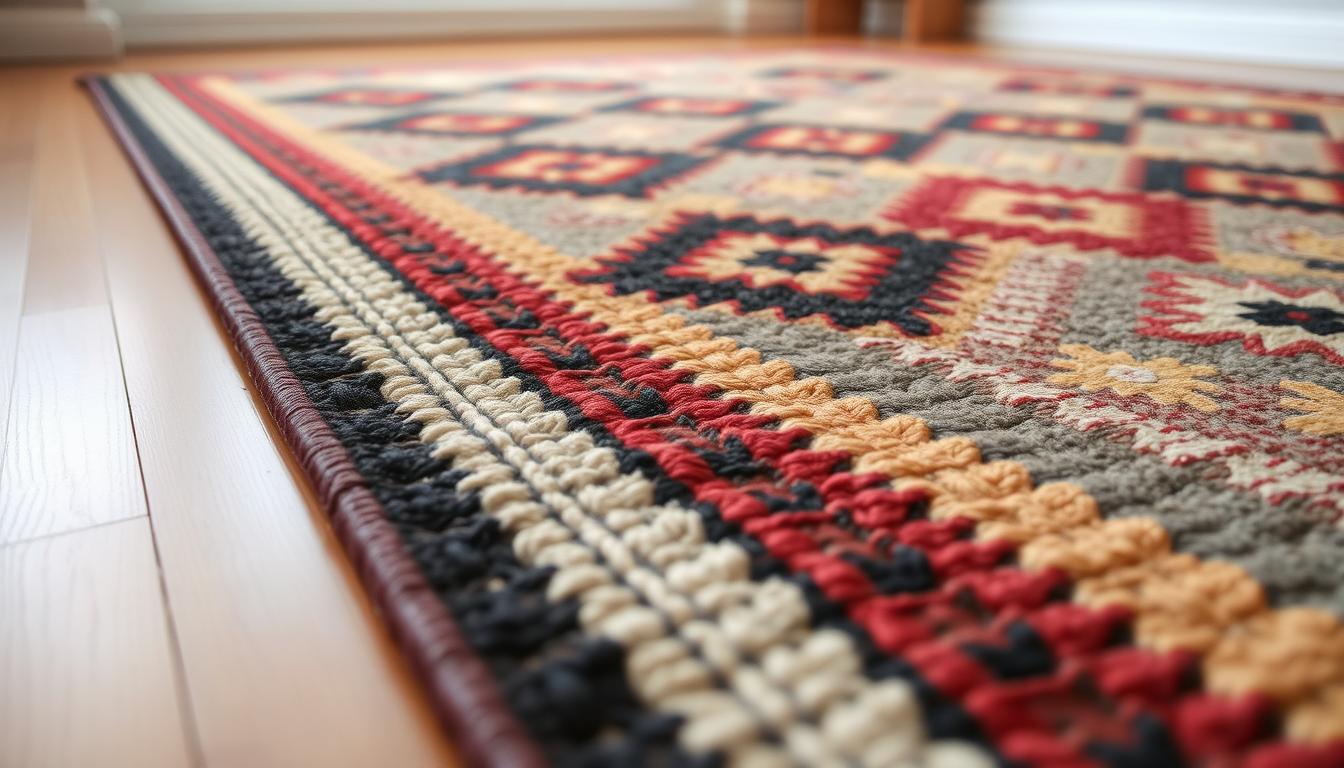
6 Must-Know Facts About Using Kilim Rugs Outdoors
What if your patio décor could carry the resilience of ancient nomadic wisdom? For over a thousand years, flatwoven textiles from Turkey’s rugged landscapes have weathered sandstorms, animal traffic, and harsh sun—without losing their vibrant patterns. Today, these timeless pieces offer more than history: they bring unmatched durability to modern outdoor spaces.

Originally crafted by Middle Eastern tribes, kilim designs served as tent floors, saddle covers, and portable ground cloths. Their tight, pile-free weave resists moisture and fading better than traditional rugs. This makes them ideal for patios, decks, or pool areas where heavy use is inevitable.
But not all kilims thrive outside equally. Factors like dye quality, weaving techniques, and fiber blends determine longevity. You’ll need to know how to choose the right piece—and care for it—to enjoy its beauty season after season.
Key Takeaways
- Kilim textiles originate from nomadic cultures that relied on them for outdoor survival.
- Flatwoven construction prevents water absorption and mold growth.
- Natural dyes in vintage pieces may fade faster than modern color-fast alternatives.
- Lightweight designs simplify seasonal storage compared to bulkier options.
- Pattern density impacts stain visibility in high-traffic areas.
- UV-resistant fibers help maintain vibrant hues under direct sunlight.
Introduction to Kilim Rugs
Imagine holding fabric that survived empires and migrations. Kilim textiles carry this legacy through their unique construction. Unlike standard floor coverings, they blend artistry with engineering perfected over 1,500 years.
What Is a Kilim Rug?
These textiles get their name from the Persian "gelim" – meaning "to spread roughly." Artisans weave horizontal (weft) and vertical (warp) threads tightly, creating patterns visible on both sides. This flatwoven technique produces rugs that are:
| Feature | Kilim | Traditional Rug |
|---|---|---|
| Thickness | 1/4 inch | 1 inch+ |
| Reversibility | Yes | No |
| Weight | 5-8 lbs/sq.yd | 12-20 lbs/sq.yd |
The absence of pile (raised fibers) makes them naturally resistant to crushing. You can flip them seasonally to even out wear – a trick nomadic weavers used for centuries.
Historical & Cultural Significance
Fifth-century Siberian burial sites revealed the oldest known examples. Nomads relied on these textiles for tent walls, bedding, and ceremonial purposes. Their interweaving methods created signature geometric slits – not flaws, but proof of authentic craftsmanship.
Patterns often held symbolic meaning. Triangles represented protection, while diamonds signaled fertility. This cultural coding turns each piece into a storytelling canvas that withstands weather as well as time.
The Craftsmanship Behind Kilim Rugs
The creation of a kilim begins with hands moving in rhythms perfected over centuries. Artisans don’t just weave fibers—they encode cultural memory into every strand. This meticulous approach yields textiles that endure through generations while maintaining structural integrity.

Traditional Weaving Techniques
Skilled weavers interlock warp (vertical) and weft (horizontal) threads using a slit-tapestry method. Unlike knotted rugs, this technique creates crisp geometric patterns without bulky piles. The flat surface resists dirt accumulation—a critical feature for high-traffic areas.
One 9x6 foot piece demands up to 16 weeks of labor. Experienced craftspeople maintain consistent tension across thousands of threads, preventing warping or gaps. This precision ensures your textile won’t unravel or lose shape over time.
Materials & Natural Dyes
Premium kilims use 100% wool—a fiber naturally resistant to moisture and UV damage. Its coiled structure repels liquids, making spills bead up instead of soaking through. Unlike synthetic blends, wool retains flexibility in temperature swings.
Colors come from botanical sources:
- Madder root produces terra-cotta reds
- Walnut shells create chocolate browns
- Double-dyed indigo and weld yield forest greens
These organic pigments mellow gracefully outdoors rather than fading abruptly. Each dye batch varies slightly, giving your piece a unique chromatic fingerprint.
Exploring Different Kilim Rug Styles
From sun-baked deserts to mountain villages, regional weaving traditions shape kilim aesthetics and performance. Each style carries unique advantages for outdoor spaces, balancing visual impact with practical resilience.
Red & Chobi Kilims
Ghalmouri pieces stand out with their crimson hues and 120 knots per square inch—nearly double standard counts. This density creates surfaces that resist dirt penetration, ideal for patios with frequent foot traffic. Their wool fibers naturally repel moisture, preventing mildew in humid climates.
Maymana versions showcase Central Asia’s heritage through bold diamonds and zigzag motifs. Though slightly looser in weave, their vegetable-dyed colors age gracefully under sunlight. Pair these with wrought iron furniture for a rustic outdoor aesthetic.
Chobi designs soften spaces with nature-inspired palettes. Artisans layer sage greens and terracotta oranges using double-weft techniques, resulting in patterns that hide grass stains effectively. Mid-weight construction allows easy shaking to remove debris.
Barjasta Kilims Explained
This innovative hybrid merges flatwoven bases with raised diamond motifs. The textured patterns add depth to outdoor seating areas while maintaining easy cleanability. Unlike traditional piled rugs, Barjasta’s low-profile loops won’t trap leaves or pebbles.
Modern synthetic dyes in these pieces resist UV fading better than natural alternatives. Their blend of cotton and wool withstands temperature swings, making them suitable for four-season climates. Rotate them quarterly to ensure even sun exposure across the design.
Can Kilim Rugs Be Used Outdoors
Picture your outdoor space transformed by textiles that have braved centuries of harsh elements. The same flatwoven construction that protected nomadic tribes from desert sands now offers weather-ready performance for modern exterior designs.

Practical Outdoor Uses
These textiles shine in spaces where others falter. Ideal placements include:
- Pool decks: Water beads up instead of soaking through
- Patio dining zones: Hide food spills with intricate patterns
- Firepit surrounds: Wool fibers resist sparks better than synthetics
Tips for Maintaining Outdoor Durability
Rotate your piece every 3 months to prevent uneven fading. For stubborn dirt, follow our simple cleaning routine using just water and mild soap. Avoid leaving them damp overnight – morning sun drying works best.
In snowy regions, roll and store during heavy winter months. For year-round use in sunny climates, choose pieces with UV-resistant synthetic dyes. The tight weave naturally resists mold, but ensure proper airflow beneath the textile.
Caring for Your Kilim Rug Outdoors
Maintaining outdoor textiles shouldn’t feel like deciphering ancient scrolls. These flatwoven treasures thrive with care methods as straightforward as their geometric patterns. Follow these practical steps to preserve their colors and structure through seasons.
Easy Cleaning and Upkeep
Start with weekly vacuuming using a brushless attachment. This prevents dirt from settling into the weave while keeping fibers springy. For deeper cleaning, lay your piece on a flat surface and spray evenly with a garden hose—no harsh chemicals needed.
Sun-drying works best when you rotate the textile every 2-3 hours. This prevents uneven fading, especially with vegetable-dyed pieces. Pro tip: Shake vigorously before washing to dislodge debris trapped in the tight weave.
Stubborn stains? Mix equal parts water and white vinegar. Blot gently—never scrub—to lift marks without damaging threads. For grease spots, sprinkle cornstarch, let sit for 15 minutes, then brush away.
Seasonal storage matters. Roll—never fold—your textile and store in a breathable cotton bag. Follow these proper care techniques to maintain its original look for decades. The same methods nomadic weavers used still deliver results today.
Quality and Price: Getting the Best Value
Why do some flatwoven textiles last generations while others fade quickly? The answer lies in weave density and material choices. Kilims stand out as budget-friendly options among handmade floor coverings, but their price tags vary widely based on craftsmanship.
Understanding Weave Quality
Run your fingers across a kilim’s surface. Premium pieces feel like polished stone – smooth yet firm. This comes from knot density, measured by horizontal threads per inch. Higher counts create intricate patterns that withstand wear while repelling dirt.
| Weave Density | Pattern Clarity | Texture | Price Range |
|---|---|---|---|
| 60-80 threads/inch | Visible gaps | Coarse | $675-$1,200 |
| 100-120 threads/inch | Crisp edges | Soft | $1,800-$3,500 |
| 140+ threads/inch | Photographic detail | Silky | $4,000-$7,000+ |
Denser weaves use thinner wool strands, requiring advanced skills. These pieces often feature symbolic motifs passed through weaving families. Check for uniform tension by holding the textile to light – gaps indicate rushed work.
Price Factors and Affordability
Three elements determine cost: labor hours, wool quality, and pattern complexity. Flatweaving takes 70% less time than hand-knotted rugs, cutting production costs. Natural dyes from plants like indigo add $200-$500 versus synthetic colors.
For outdoor use, prioritize mid-range pieces (100 threads/inch). They balance durability with affordability. Always follow the recommended cleaning methods to protect your investment. A well-maintained kilim gains character over decades, much like weathered leather.
Design and Styling Ideas for Kilim Rugs
Merge history with modernity by introducing timeless weaves into your everyday spaces. These textiles bring bold geometric patterns and symbolic motifs to any room, from sunlit porches to minimalist living areas. Explore 7 surprising facts about these to understand their enduring appeal across design eras.
Seamless Style Transitions
Triangles representing protection or diamonds symbolizing fertility add depth beyond aesthetics. Layer a vintage piece under a neutral sofa to anchor eclectic spaces. Flip the rug seasonally—its reversible nature offers fresh looks without buying new decor.
In contemporary homes, pair high-contrast stripes with sleek furniture for balance. Outdoor settings benefit from dense patterns that camouflage dirt. Use smaller versions as table runners or wall art to extend the theme throughout your space.
FAQ
What makes a kilim rug different from other handmade rugs?
Unlike pile rugs, kilims are flatwoven with no raised fibers. Artisans interlace colored wool or cotton threads tightly using traditional techniques, creating durable geometric patterns. This method gives them a lightweight, reversible form ideal for high-traffic areas.
Are natural dyes used in authentic kilim designs?
Yes. Many high-quality pieces feature plant-based dyes like indigo, pomegranate, or walnut husks. These organic materials produce rich, earthy tones that age beautifully over time. Check product descriptions for terms like “vegetable-dyed” to confirm.
How do weather conditions affect outdoor durability?
Prolonged moisture or direct sunlight can fade colors or weaken fibers. For longevity, place your rug in covered spaces like patios and use UV-protective sprays. Rotate it periodically to ensure even exposure.
Can geometric motifs hold up in modern design schemes?
Absolutely. Bold tribal patterns add contrast to minimalist or bohemian interiors. Pair red Chobi kilims with neutral furniture or layer Barjasta styles under outdoor seating for a textured, eclectic look.
Why does weave quality impact pricing?
Tightly woven threads and intricate designs require more labor, raising costs. Higher-quality pieces from regions like Turkey or Persia often use premium wool, ensuring they retain shape and value longer than mass-produced alternatives.
What’s the best way to clean a flatwoven rug outdoors?
Shake off debris regularly and spot-clean stains with mild soap. Avoid harsh chemicals, which can strip natural dyes. For deep cleaning, professional services familiar with handmade textiles are recommended.
Are jute backings necessary for outdoor use?
While not essential, non-slip liners prevent shifting on hard surfaces. They also add an extra layer of protection against moisture, especially in humid climates or near pools.









